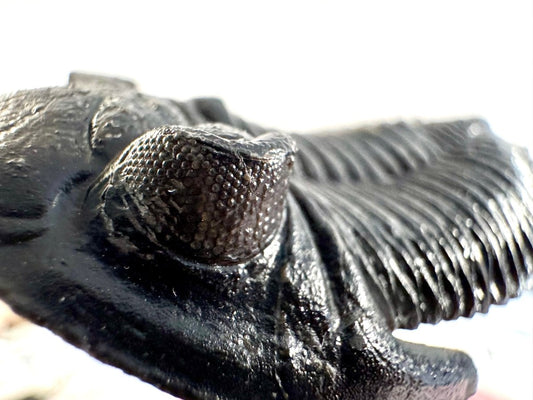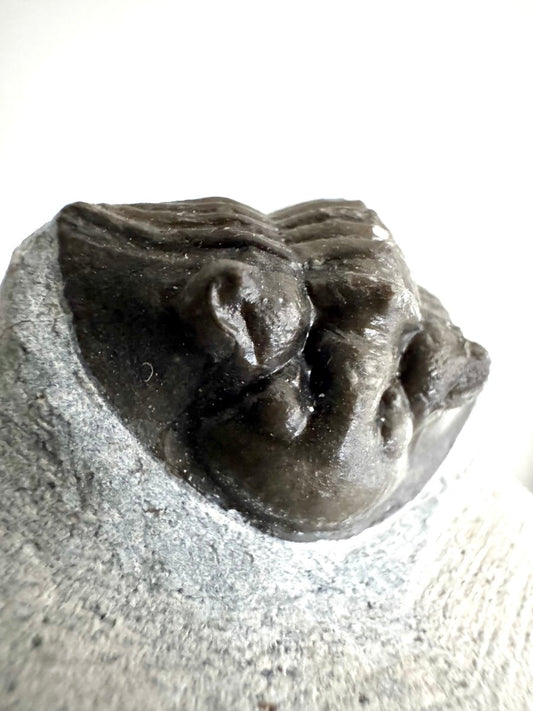Trilobites – Ancient Arthropods of the Paleozoic Seas
Trilobites are one of the earliest known groups of arthropods and among the most recognizable fossils. These fascinating creatures roamed Earth's oceans for an astounding 270 million years, from the early Cambrian period (around 521 million years ago) to the end of the Permian (about 252 million years ago). Their fossils provide us with an incredible record of early marine life and offer a window into Earth’s ancient ecosystems.
What Are Trilobites?
Trilobites belong to the phylum Arthropoda, which includes insects, spiders, and crustaceans. They were marine invertebrates with segmented bodies and exoskeletons that molted as they grew, similar to modern arthropods. The name “trilobite” comes from the three longitudinal lobes (central and two side lobes) that characterize their body plan.
Anatomy and Structure
Trilobites have a distinct three-part body structure:
- Cephalon (Head): The head section housed the eyes, mouthparts, and often elaborate spines or ornamentation. Trilobites were among the first animals to develop complex, compound eyes made of calcite, similar in structure to insect eyes today.
- Thorax (Body): The middle section was divided into segments, which allowed for flexibility. Some species could even curl up into a ball for protection, much like modern pill bugs.
- Pygidium (Tail): The tail section was often fused and varied in size and shape among different species.
Trilobite Diversity
Trilobites are one of the most diverse groups of prehistoric life, with over 20,000 known species across more than 10 orders. They came in a wide range of sizes, from a few millimeters to over 70 centimeters in length. Their shapes and adaptations varied widely depending on their environment. Some had large, spiny exoskeletons for defense, while others developed streamlined bodies for burrowing or swimming.
Trilobites were remarkably adaptable creatures and occupied many ecological niches. Different species evolved to fit various lifestyles, including:
- Predators: Some trilobites were active hunters, using their spiny legs to capture prey.
- Scavengers: Others were scavengers, feeding on organic material on the sea floor.
- Filter Feeders: Some trilobites developed specialized appendages to sift through sediment and collect food particles.
Most trilobites lived in shallow marine environments, but fossil evidence shows that some ventured into deeper waters. Their wide distribution and adaptability contributed to their long evolutionary history.

Molting and Growth
Like modern arthropods, trilobites shed their exoskeletons as they grew—a process called molting. This feature has left behind a wealth of fossil evidence, with many trilobite fossils being remnants of their discarded exoskeletons. Each molt preserved a moment in the life of a trilobite, allowing scientists to study their development and even infer their behavior.
Trilobite Eyes
One of the most remarkable features of trilobites is their compound eyes. Trilobite eyes are unique in that they are made from calcite, a mineral that was part of their exoskeleton. This adaptation allowed them to see clearly underwater, an advantage that helped them avoid predators and find food. The study of trilobite eyes has provided scientists with crucial insights into the evolution of vision, especially among early marine animals.
Fossil Record of Trilobites
Trilobites are some of the best-known fossils, and their remains are found on every continent. Their extensive fossil record makes them invaluable to paleontologists, especially in stratigraphy. Like ammonites, trilobites evolved rapidly and are considered excellent index fossils. This means they can help date the age of rock layers and correlate layers between distant geographic locations.
The End of Trilobites
Trilobites were resilient animals that survived multiple mass extinctions, including the Ordovician-Silurian extinction and the Devonian extinction. However, they could not withstand the environmental upheavals of the Permian extinction, the largest mass extinction in Earth’s history, which wiped out more than 90% of marine species. Trilobites, along with many other ancient marine organisms, became extinct around 252 million years ago, marking the end of their long reign in Earth’s oceans.
Collecting and Appreciating Trilobites
Due to their striking appearance and accessibility, trilobites are highly sought after by fossil collectors. Some trilobite fossils are incredibly well-preserved, showing detailed features like eyes and spines. Certain species, such as those from the Devonian limestone of Morocco, are especially prized for their intricate details and fossilized spines.
Trilobite fossils for sale
-
Hollardops Mesocristata Trilobite Fossil (2.65") – Devonian Period, Morocco
Regular price €185,00 EURRegular priceUnit price / per -
Crotalocephalus Gibbus Trilobite Fossil (3.49") - Devonian Period, Morocco
Regular price €220,00 EURRegular priceUnit price / per -
Scutellum sp. Trilobite fossil on Matrix (1.20") – Devonian, Morocco
Regular price €85,00 EURRegular priceUnit price / per -
Harpes Trilobite fossil on matrix (2.05") - Devonian, Morocco
Regular price €260,00 EURRegular priceUnit price / per -
Morocops Trilobite fossil on matrix (2.15") - Devonian, Morocco
Regular price €85,00 EURRegular priceUnit price / per -
Morocops Trilobite fossil on matrix (1.70") - Devonian, Morocco (Copy)
Regular price €80,00 EURRegular priceUnit price / per -
Morocops Trilobite fossil on matrix (2.10") - Devonian, Morocco
Regular price €80,00 EURRegular priceUnit price / per -
Crotalocephalus Gibbus Trilobite Fossil (3.08") - Devonian Period, Morocco
Regular price €90,00 EURRegular priceUnit price / per -
Crotalocephalus Gibbus Trilobite Fossil (2.42") - Devonian Period, Morocco
Regular price €80,00 EURRegular priceUnit price / per -
Trilobite fossil, Damesella Paronai (3.50"), Cambrian period, China
Regular price €475,00 EURRegular priceUnit price / per -
Trilobite fossil, Damesella Paronai (2.05"), Cambrian period, China
Regular price €325,00 EURRegular priceUnit price / per -
Peronopsis interstrictus Trilobite Fossil on matrix – Cambrian, Utah, USA (P005)
Regular price €10,95 EURRegular priceUnit price / per -
Peronopsis interstrictus Trilobite Fossil on matrix – Cambrian, Utah, USA (P004)
Regular price €10,95 EURRegular priceUnit price / per -
Peronopsis interstrictus Trilobite Fossil on matrix – Cambrian, Utah, USA (P003)
Regular price €10,95 EURRegular priceUnit price / per -
Peronopsis interstrictus Trilobite Fossil on matrix – Cambrian, Utah, USA (P002)
Regular price €10,95 EURRegular priceUnit price / per -
Peronopsis interstrictus Trilobite Fossil on matrix – Cambrian, Utah, USA (P001)
Regular price €10,95 EURRegular priceUnit price / per -
Elrathia Kingii Trilobite Fossil (1.65") – Cambrian, Utah, USA
Regular price €49,00 EURRegular priceUnit price / per -
XL Elrathia Kingii Trilobite Fossil (1.88") – Cambrian, Utah, USA
Regular price €69,00 EURRegular priceUnit price / per -
Morocops Trilobite fossil rolled up, Devonian period (1.13")
Regular price €56,95 EURRegular priceUnit price / per -
Gerastos granulosus Trilobite Fossil (A001)
Regular price €15,00 EURRegular priceUnit price / per -
Trilobite fossil, Large Damesella Paronai
Regular price €180,00 EURRegular priceUnit price / per -
Trilobite fossil, Cyphaspis Kraidensis
Regular price €79,95 EURRegular priceUnit price / per -
Trilobite fossil from China, Rare Damesella Paronai
Regular price €300,00 EURRegular priceUnit price / per -
Chotecops ferdinandi trilobite fossil (Bundenbach)
Regular price €165,00 EURRegular priceUnit price / per -
Zlichovaspis Trilobite Fossil (3.39") – Devonian Period, Morocco
Regular price €365,00 EURRegular priceUnit price / per


















































